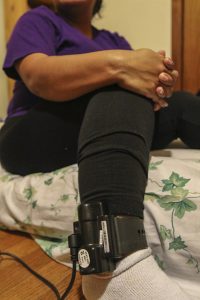
Yesterday, California governor Jerry Brown brought some relief to those caught up in the juvenile legal system and their families by signing a number of bills into law. One of these, SB 190, will bring an end to charges for electronic monitoring (EM).
Electronic monitoring of juveniles has expanded in recent years, especially in low income communities of color. Daily fees for being on the monitor in some jurisdictions have reached as high as thirty dollars, often with additional charges for mandatory landline phones and setting up the device. Some vulnerable families have been paying more for monitoring every month than they do for food. Abolishing these fees is long overdue. Not only have families paid for having their children monitored, but according to Kate Weisburd, Director of the Youth Defender Clinic at the East Bay Community Law Center in Berkeley, rule violations of electronic monitoring are common. These result in the young person being put back into detention. Under previous California legislation, parents of juveniles must also pay a daily fee for the time their child is in detention.
Eliminating fees is a major step toward addressing the problems caused by using ankle shackles on young people, but many problems remain. First, house arrest, almost always part of electronic monitoring rules, isolates individuals, stunting the development of their social skills and narrowing their world at a time when they need to be building toward a future. Second, placing youth on monitors with house arrest assumes that everyone’s household fits some idealized middle-class mold where they can retreat to the privacy of their bedroom with posters of Beyonce and Jay-Z on the wall and chill. But this one-size-fits-all approach neglects the reality that most youth who are involved in the criminal legal system come from households which are under-resourced and in many instances may be a source of harm rather than a peaceful escape. In fact, according to Weisburd, there is no evidence that EM “furthers rehabilitative goals” and may in fact “undermine rehabilitation.” Ultimately, we need to stop incarcerating young people, whether it is in formal lockups or in technological EM prisons in their living room. Every cent spent on electronic monitoring and other punitive policies could be better allocated to programs to provide opportunities that keep young people miles away from the school to prison pipeline.



